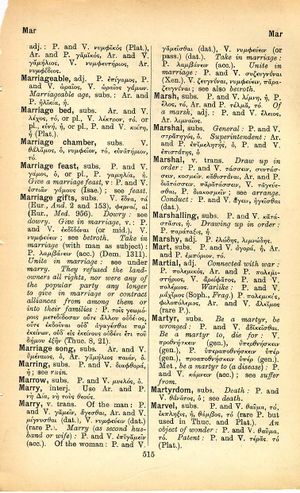marry: Difference between revisions
From LSJ
(Woodhouse 3) |
(CSV4) |
||
| Line 1: | Line 1: | ||
{{ | {{Woodhouse1 | ||
| | |Text=[[File:woodhouse_515.jpg|thumb|link={{filepath:woodhouse_515.jpg}}]]'''interj.''' | ||
Use Ar. and P. νὴ Δία, νὴ τοὺς θεούς. | |||
'''v. trans.''' | |||
Of the man: P. and V. γαμεῖν, ἄγεσθαι, Ar. and V. μίγνυσθαι (dat.), V. νυμφεύειν (dat.) (rare P.). | |||
<b class="b2">Marry</b> (<b class="b2">as second husband or</b> <b class="b2">wife</b>): P. and V. ἐπιγαμεῖν (acc.). | |||
Of the woman: P. and V. γαμεῖσθαι (dat.), V. νυμφεύειν (or pass.) (dat.). | |||
<b class="b2">Take in marriage</b>: P. [[λαμβάνω|λαμβάνειν]] (acc.). | |||
<b class="b2">Unite in marriage</b>: P. and V. συζευγνύναι (Xen.). V. ζευγνύναι, νυμφεύειν, παραζευγνύναι; see also [[betroth]]. | |||
}} | }} | ||
Revision as of 09:46, 21 July 2017
English > Greek (Woodhouse)
interj.
Use Ar. and P. νὴ Δία, νὴ τοὺς θεούς. v. trans. Of the man: P. and V. γαμεῖν, ἄγεσθαι, Ar. and V. μίγνυσθαι (dat.), V. νυμφεύειν (dat.) (rare P.). Marry (as second husband or wife): P. and V. ἐπιγαμεῖν (acc.). Of the woman: P. and V. γαμεῖσθαι (dat.), V. νυμφεύειν (or pass.) (dat.). Take in marriage: P. λαμβάνειν (acc.). Unite in marriage: P. and V. συζευγνύναι (Xen.). V. ζευγνύναι, νυμφεύειν, παραζευγνύναι; see also betroth.

